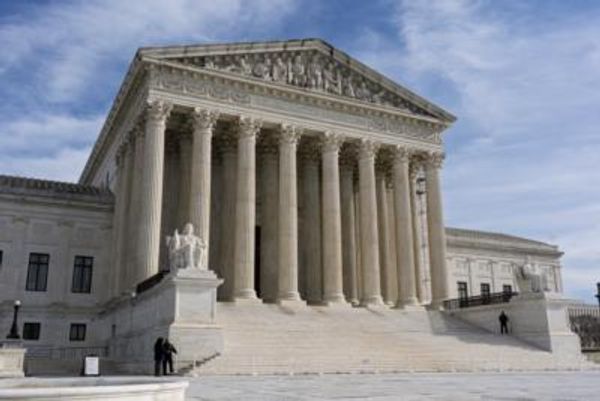
The recent death of U.S. Supreme Court Justice Ruth Bader Ginsburg aggravated deep problems in American democracy.
No sooner had Ginsburg’s death been announced than President Donald Trump and Senate Republicans made clear that they would immediately move to replace her just six weeks before an election, despite blocking even a hearing on former President Barack Obama’s Supreme Court nominee when Justice Antonin Scalia died nine months before the 2016 election. This move was hypocritical as well as deeply damaging to democracy, since it manipulated the rules of the game for partisan advantage and made the court appear a political pawn of the party in power. Moreover, should Trump’s nominee, Amy Coney Barrett, be confirmed, the Supreme Court would have a 6-3 conservative majority—one that would likely endure for years to come.
Democrats have responded to this possibility with rage, arguing that the time for playing by the rules is over. Calls for things such as “packing” the court by adding justices to neuter the conservative majority have exploded. Some go further, arguing for destroying whatever remains of the court’s independence, and thus its ability to act as a check on other branches of government.
Aaron Belkin, for example, co-founder of the group Take Back the Court—a group opposed to conservative Supreme Court majorities and an open advocate of packing—has argued that since the Republicans have “stolen” the courts, the judges they have appointed are “illegitimately appointed,” and that because the Supreme Court is “working to destroy democracy,” Democrats are justified in doing whatever is necessary to gain control over it. Ryan Cooper, a columnist at the Week, has similarly argued that the “easiest way to get around potentially tyrannical right-wing justices” is simply to “ignore them.” There is no way, after all, that the Supreme Court can force the president “to obey” it.
There are obvious problems with these suggestions. They are unlikely to be effective—court-packing, for example, seems likely to set off a tit-for-tat expansion of the court that would benefit no one—as well as likely to further weaken democracy by deepening polarization and the delegitimization of the courts. Former President Franklin D. Roosevelt’s attempt to pack the court after it opposed some of his New Deal legislation was shut down and may have deepened opposition to him, although conservatives were opposed to his policies more generally.
Supporters of such suggestions rarely grapple with the question of how Republicans got to be in a position to dominate the Supreme Court in the first place. To the degree this question is considered, answers generally focus on Republicans’ use of dirty tricks and willingness to play constitutional hardball (that is, to exploit any technically legal right to get one’s way). While Republicans are surely guilty of these things, the real story is more complicated, and grappling with it is necessary in order to understand as well as design responses to the problems facing U.S. democracy today.
Conservative domination of the courts is the culmination of a multipronged political strategy that began decades ago, when conservatives were in a situation similar to that facing liberals today.
The Supreme Court under Chief Justice Earl Warren, from 1953 to 1969, was the most liberal in history, issuing decisions that reshaped U.S. society and revolutionized constitutional interpretation. The Warren court dramatically expanded civil and voting rights with decisions such as Brown v. Board of Education, Gomillion v. Lightfoot, and Loving v. Virginia; remade the relationship between church and state and between state and federal governments; transformed criminal law; affirmed a constitutionally protected right of privacy, laying the groundwork for the Roe v. Wade decision legalizing abortion, and more. Many of these decisions were taken, moreover, over the “strong and bitter objections of a majority of the American people.”
From the perspective of conservatives, the larger political context only made things worse. Despite conservative hopes that the New Deal would be rolled back after the war and Roosevelt’s death, much of it remained intact. Even President Dwight D. Eisenhower, a Republican, did not attack it head on, leading conservatives to charge him with being “a quisling in thrall to the Democrats” and a “socialist.” And during much of the 1960s Democrats controlled the presidency—enabling them to enact further transformative liberal reforms including the Civil Rights Act of 1964, the Voting Rights Act of 1965, and the Great Society—as well as dominating state-level governments, holding governorships and legislative majorities in 40 percent of them, while the Republicans controlled fewer than 20 percent.
In was in this context that the modern conservative movement emerged. Conservatives recognized that countering the changes wrought by the Warren court and liberal domination of political life would require capturing political power. But given the disadvantages they faced, capturing this power would require a long-term and multifaceted strategy.
Conservatives accordingly established a wide range of institutions, including the Heritage Foundation, the Cato Institute, and the Manhattan Institute for Policy Research, to spread conservative ideas and shape public debate. (Scholars have found these institutions to be less policy-focused and more openly ideological than their liberal counterparts.) Conservatives also established organizations to help win elections and shape policymaking.
Groups such as the American Legislative Exchange Council (ALEC) and the State Policy Network created networks among local business interests, Republican politicians, and conservative activists; prepared op-eds and other media campaigns in favor of conservative policies; recruited and supported conservative candidates; and prepared “model” bills for conservative legislators. Many of these organizations focused on the state and local level, reflecting a recognition that policymaking on many issues conservatives cared about—including voting access, redistricting, unionization, reproductive rights, education, health care, and more—happened there, not in Washington.
By any measure, these organizations have been remarkably successful. Following the 1976 elections, the Republicans didn’t control a single state’s legislative and executive branches. Today, the party has unified control of 20 state legislatures and governorships; the Democrats completely control just 15 states (an improvement from 2016, when they had full control of only 6).
These organizations have also played a critical role in advancing a unified conservative policy agenda. As Alexander Hertel-Fernandez and other scholars have shown, during the past decades hundreds of bills dealing with industry deregulation, the privatization of state services, labor-market protections, the environment, and more that were “drafted by ALEC task forces were passed by nearly every state legislature.”
Conservatives also understood that shifting political dynamics over the long term required undermining the power of their opponents. Thus organizations such as Americans for Prosperity (AFP), the political advocacy group funded by the Koch brothers, diligently and deliberately supported anti-union bills and politicians, particularly in states such as Michigan, Ohio, and Wisconsin, where unions were politically influential and crucial allies of the Democratic Party.
For example, in discussing AFP’s role in former Gov. Scott Walker’s anti-union crusade in Wisconsin, one AFP leader noted that this victory required a diligent, multifaceted strategy that included town halls, a media campaign, and the recruitment “of more grassroots activists … than the Wisconsin teacher’s union [had] members. That’s how you change a state,” he bragged.
Another clear example of a sustained, strategic effort by conservative organizations to undermine opponents and shift political dynamics occurred, of course, with the courts.
The Federalist Society is the well-known face of these efforts: At least four of the five conservative Supreme Court justices have been members, and it has provided Trump and his Republican predecessors with lists of nominees for the Supreme Court and lower-level courts. As the conservative magazine National Review—an organ of the conservative political movement that began in the Eisenhower era—noted recently, the “rise and nomination of Amy Coney Barrett is a testament to the work of generations of people tending to conservative institutions.”
Rather than focusing on efforts such as court-packing that are likely to be ineffective and other changes that are likely to weaken the courts’ independence further and thus undermine democracy, Democrats should grapple with the question of how Republicans achieved this dominance in the first place. Those advocating short-term measures that could delegitimize the Supreme Court are missing the bigger picture. Many liberals seem to think it is only through dirty tricks or unrepresentative institutions such as the Senate and the Electoral College that Republicans win. While these things surely help Republicans, they fail to fully explain Republicans’ success, especially state-level victories where the Senate and Electoral College play no role.
Facing a similar situation to what liberals face today, conservatives undertook a different and more difficult strategy in response—they embarked on a long-term effort to spread conservative ideas, win elections, and gradually reshape U.S. society and political institutions from the ground up. These efforts began in the mid-1950s, continued through the 1960s, and paid clear dividends by 1980 with the election of President Ronald Reagan. The dirty tricks and constitutional hardball so successfully employed by Republicans were a consequence of the power gained by this strategy rather than the entire strategy itself.
With the Supreme Court in conservative hands and Democrats facing significant structural disadvantages at the national level—including an Electoral College and Senate that provide disproportionate power to states controlled by Republicans—Democrats will need to embark on a multipronged, long-term effort of their own if they want to recapture the power to appoint judges and reshape political dynamics in this country not just after this election, but for years into the future.
Democrats might also learn from conservatives the value of focusing on the state and local level—not only because Democrats are so clearly at a disadvantage there, but also because a critical consequence of a conservative Supreme Court is that many of its decisions would simply return even more crucial policymaking power to the states. And it is at this level that Republicans have excelled, using their control of state governments in recent years to undermine Democratic priorities, including voting rights, redistricting, health care, and, of course, abortion rights.
It is worth remembering that should a conservative Supreme Court majority overturn Roe v. Wade, access to abortion won’t end; it will instead depend on which state you live in. But as Joan Williams recently noted, thanks to Republican efforts at the state level over the past years, access to reproductive services “already depends on where you live.” Even with Roe v. Wade in place, there is “no abortion clinic in 90 percent of American counties.” The fight over abortion has been going on at the state level for quite a while, but one party has been much more successful in waging this battle than the other.
Democrats need to refocus their attention on the political fight necessary to protect abortion—a fight, by the way, that Ginsburg understood the need for. In 1992, Ginsburg gave a lecture arguing that proponents of abortion would have been better off if the Supreme Court had issued a narrower decision, leaving room for action by state legislatures which were at the time trending toward liberalizing abortion laws anyway. However, once Roe v. Wade was decided, a “political process that was moving in a reform direction” was halted, delaying the “stable settlement of the issue” that would have come from having to convince a majority of citizens of the desirability of abortion rights.
This leads to another important lesson Democrats might learn from the decades-long conservative effort that brought the United States to where it is today.
As Rick Perlstein recounts in Before the Storm, his seminal account of the formation of modern conservatism, the right understood that a conservative electorate would not simply emerge; it had to be “created.” Many observers and scholars have noted that on many of the most crucial issues facing this country—health care, inequality, gun rights, abortion, and more—a majority of voters (including significant numbers of current Republicans) actually hold left-of-center views. There is, accordingly, a potential center-left majority in the United States, but in order for that potential to become a reality and thus politically consequential, it would need to be organized and focused on electing people to office.
Democrats may indeed be involved—as Sen. Elizabeth Warren and others have argued—in “the fight of our lives,” but a prerequisite for winning a fight is clearly understanding what kind of fight it is.
Over the past years conservatives have managed to achieve a remarkable amount of what they set out to do decades before. That they have been able to do so is testament to an impressive movement and decades of determination. If Democrats hope to reverse the policies implemented by Trump and the Republicans and reinforce U.S. democracy, they will need to do more than win the next election and rail against the conservative Supreme Court. They will need a similar long-term strategy capable of building a Democratic electorate and winning elections not merely at the national, but also at the state and local levels, for many years to come.







